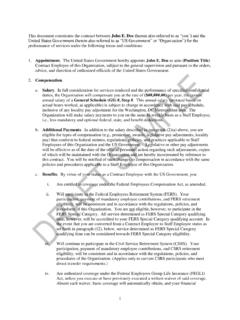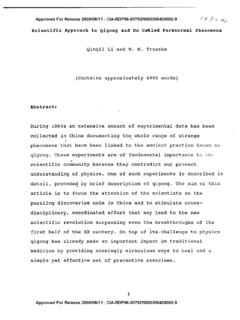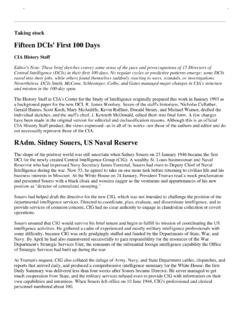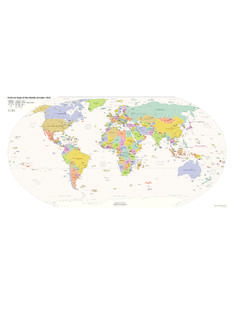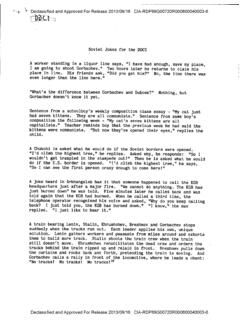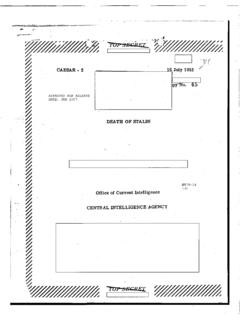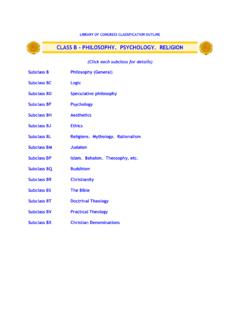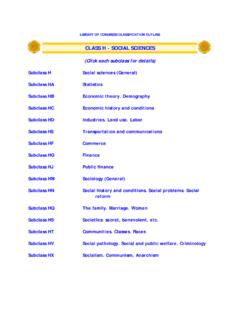Transcription of THE 2030 SPIKE - CIA
1 THE2030 SPIKECOUNTDOWN TOGLOBALCATASTROPHEC olin MasonLondon Sterling, VAFirst published in the UK and USA in 2003 by Earthscan Publications LtdReprinted 2004 Copyright Colin Mason, 2003 All rights reservedISBN: 1-84407-018-2 Typesetting by MapSet Ltd, Gateshead, UKPrinted and bound in the UK by Creative Print and Design (Wales), Ebbw ValeCover design by Ruth BatesonFor a full list of publications please contact:Earthscan 8 12 Camden High Street, London, NW1 0JH, UKTel: +44 (0)20 7387 8558 Fax: +44 (0)20 7387 8998 Email: Quicksilver Drive, Sterling, VA 20166-2012, USAE arthscan publishes in association with WWF-UK and the InternationalInstitute for Environment and DevelopmentAcatalogue record for this book is available from the British LibraryLibrary of congress cataloging -in-Publication DataMason, Colin, 1926-The 2030 SPIKE : countdown to global catastrophe / Colin bibliographical references and 1-84407-018-2 (hbk.)
2 1. Twenty-first century Forecasts. 2. Environmental policy. 3. Naturalresources. 4. Social prediction. 5. Catastrophical, The. I. Title: Twothousand thirty SPIKE . II. Title: Two thousand and thirty SPIKE . III. Title:Twenty-thirty SPIKE . IV. dc212003006476 This book is printed on elemental chlorine-free paperCONTENTSA bout the AuthorvPARTONE: CRISISMODE1 The Drivers32 Running Out of Fuel: The Coming Energy Crunch93 Population and Poverty214 Climate: Too Hot or Too Cold?295 Famines: Food and Water416 One World?537 The Fourth Horseman62 PARTTWO: DIRECTIONS8 Which Way Science?759In the Genes: New Plants and People?8310 The Values of the Sea9411 Multinationals: Good Business or Bad?10112 The Trouble with Money110 PARTTHREE: UPGRADING THEINDIVIDUAL13 The Pursuit of Happiness12314 Love, Family and Freedom13015 Habitat: The Dilemma of the Cities13516 Making Education Work14517 Health and Wealth15318 Religion: The Cement of Society?
3 161 PARTFOUR: THENEWSOCIETY?19 The Mechanics of Change17120 Automation and Employment17821 Travelling Less?18622 Working Online19223 The Information Overload19924 The Toxic Culture20525 Running the Show21126 Conclusion: World to Come220 Notes230 Index244ivTHE 2030 SPIKEABOUT THEAUTHORC olin Mason, a former foreign correspondent, broadcaster andSEATO adviser to the Thai Government, was a senator in theAustralian Federal Parliament for nine years, as deputy leader ofthe Australian Democrats. He served on the Senate StandingCommittee for Science and the Environment, a Select Committeeon the effects of Agent Orange on Australian servicemen, and thefirst delegation of the Australian Parliament to China, and initi-ated the private member s bill that led to the salvation of thepristine Franklin River in Tasmania.
4 He has published 12 booksincluding the international bestselling novel Hostageand, mostrecently, AShort History of Asiawhich is currently a bestseller inits field around the or discussion on any of the issues raised in thisbook are welcomed by the author at page intentionally left MODECHAPTER1 THEDRIVERSThe decade from 2030 will see a remarkable and dangerousconfluence of world events and trends a SPIKE on the graphpaper of life that will influence humanity for good or ill as neverbefore. Combating the worst effects of this will require urgentaction, informed by the clearest possible understanding of wherewe are now and where we might action could lead us to a saner, healthier and safersociety the not too distant future could be one of unparalleledpeace, prosperity and general well-being.
5 The knowledge andresources for this are in place, or can be seen not too far have the best educated generation ever; wealth and poten-tial wealth, though badly distributed, are at their highest andincreasing, the automation of industry and agriculture promisesalmost universally high living standards and an end to thetyranny of heavy and tedious work. The world s populationmay stabilize but only if the poverty afflicting most humanscan be in London in 2001, former American president, BillClinton, called for a truly global consciousness to spread thebenefits of the 21st century around the We have themeans to make the 21st century the most peaceful and prosper-ous in human history. The question is whether we have the will. That hope is unlikely to be realized by 2030, no matter what wedo.
6 But, if effective social and economic reform can be startednow, we could see a peaceful and productive transition to a newsociety shaped by, and successfully adapted to, the oncomingadverse influences the 2030 drivers. Beyond that is a reasonableprospect of a world order better than the planet has ever the near future could be bad enough to kill tens of millionsof people in a variety of terrible ways, even plunge us into aglobal dark age, and damage the very foundations of life, whichcould take centuries to repair. The harbingers of these disastersare already with us; as I write these words an ugly and costlywar is smouldering in the Middle East, 20 million people arefacing starvation in Africa, a nuclear war has been narrowlyaverted on the Indian subcontinent, while the warnings of severewater shortages and ecological damage are becoming moreurgent.
7 So there is a clear need to choose, to establish the coursesof action that would contribute to one outcome or the other. Andthose informed choices will have to be made is considerable evidence for the 2030 SPIKE the combinedeffect of at least six adverse drivers. The most reliable estimatesset readily available oil resources at a little under a trillion barrels,and world consumption at 28 billion barrels a year, indicatingexhaustion in, at most, 34 years. Predicted increases in oil usewould reduce this time substantially. This will have major andunexpected consequences, not least a significant cut in worldfood supplies for a population that will grow to 8 billion by nuclear proliferation, policy changes in the use ofatomic weapons in the United States and Russia, confrontation inthe Middle East and South Asia, and political pressures from thedrivers, make a nuclear war of unpredictable intensity only toopossible within 20 years.
8 The consequences of this wouldseriously aggravate greenhouse effects, due to become signifi-cant by 2030. The war against terror , the growing tensionbetween Islam and the West , the doctrine that nuclear weaponscan safely be used in a limited way all these will tend to aggra-vate the effect of the International Water Management Institute predicts that abillion people will face an absolute water shortage by 2025; theUnited Nations warns of war over use of the world s rivers by2032. Problems of soil degradation, desert spread and salination,already considerable, will be out of control by 2030 in much ofthe these threats are recognized and effectivelycountered, we risk famine and deaths counted in the MODER ecent research into climate trends warn that severe globalwarming associated with carbon release from the Amazonrainforests and from methane hydrates in the Arctic is possibleby 2030, with perhaps catastrophic effects by globalwarming and sea level rises on a much lesser scale wouldadversely affect agricultural land in developing to redress the poverty most humans live in.
9 And analmost total lack of political control over globalization which isirresponsible in the pure sense of the word are likely to increaseeconomic disproportion and the conflict it causes. Populationswill increase most rapidly in the poorest countries, with the Westcontaining no more than 15 per cent of the world s people by people are aware of some of the facts surrounding someof these issues. However, because the drivers gain force by thesimple fact of their interaction, their coincidence presents uniquedangers. The major cumulative effect of the drivers, if they arepermitted to peak, will be within the lifetime of most of us certainly within that of our children. Can we avert it, or at leastsoften its impact? This is feasible but only as a result of funda-mental changes in human life and society, beginning , there is too little evidence that these dangers havebeen recognized.
10 So who will make the necessary decisions?Judging by the available demonstrable facts, governments, polit-ical hierarchies, think-tanks, dictators and military juntas aremostly saying and doing the wrong things. Those new holders ofpower, the multinationals, could play a crucial role, simplybecause they are global and so big. But to be useful, including tothemselves, their perception of the dangers of the near futuremust become clearer, their accountability guaranteed, their influ-ence more the first time in history, the means are emerging forindividuals to collectively influence the necessary decisions, usingtwo potent tools the internet and spending power. It is possibleto discern the beginnings of international networks that could putpressure on offending corporations simply by the way consumersspend their money.



